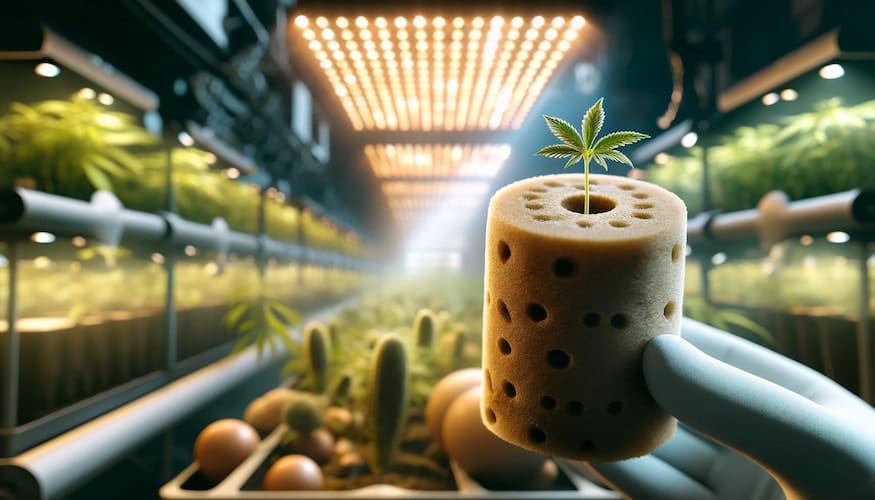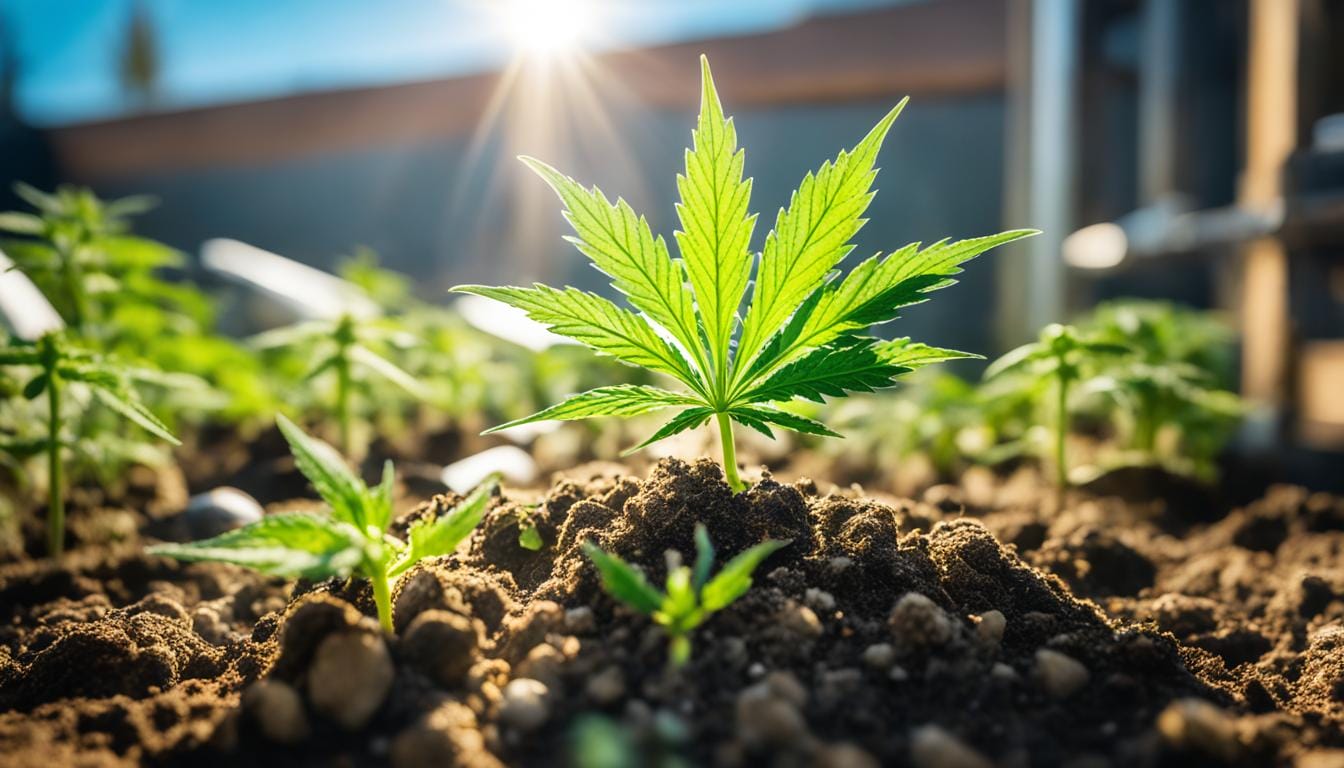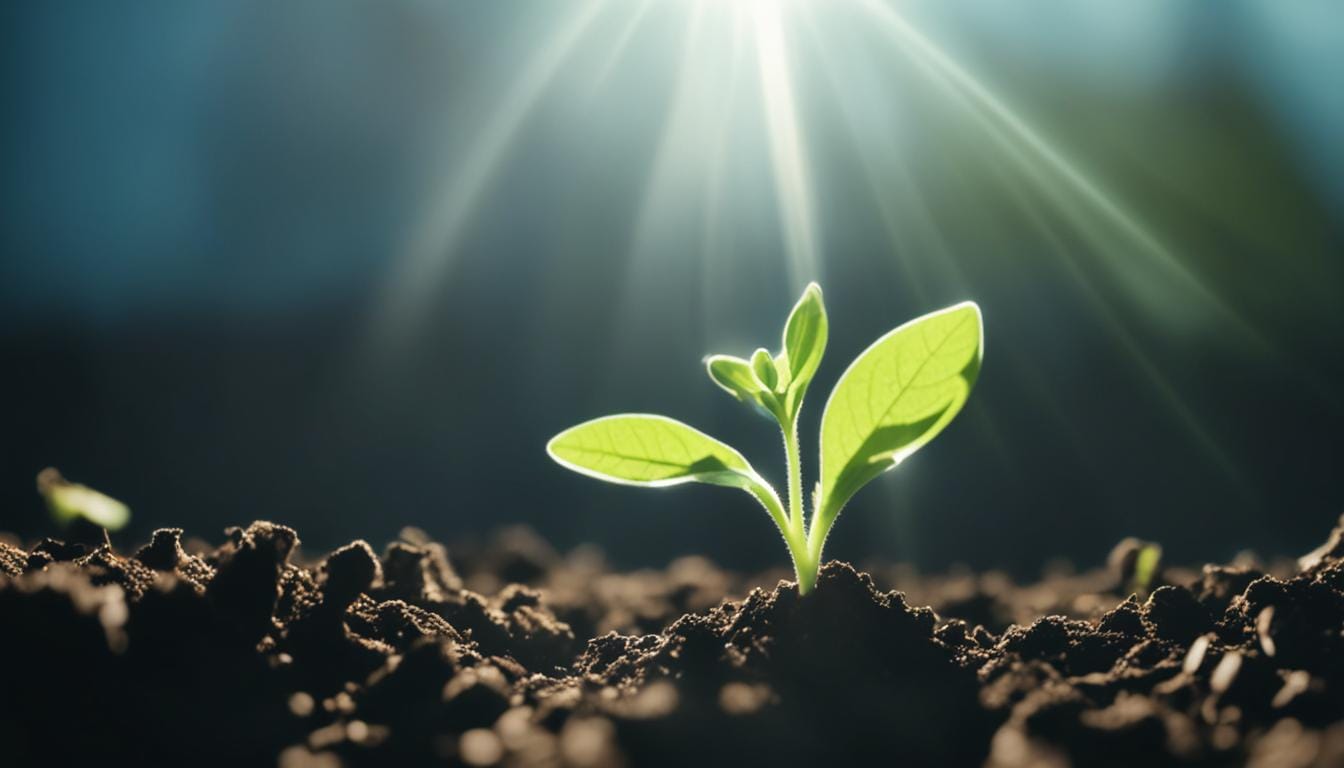Unlock the secret to successful seedlings with our guide on Using Starter Cubes and Plugs – your first step towards a thriving garden!
Direct Soil Germination: Tips for Success
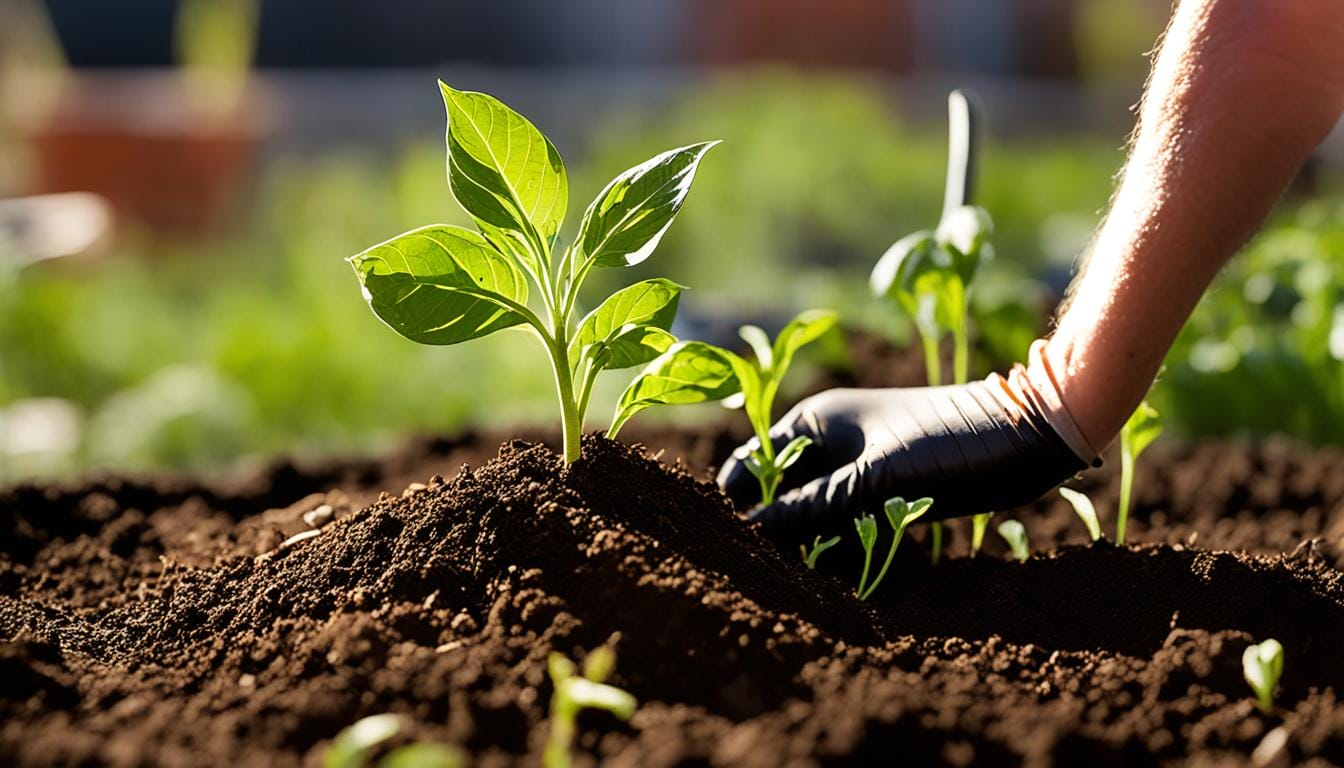
Have you ever wondered if there’s a better way to grow plants without the hassle of indoor seedlings or transplanting? What if we told you there’s a method that eliminates all these extra steps and allows you to sow your seeds directly into the soil? Welcome to the world of direct soil germination! Get ready to uncover the secrets of this revolutionary technique and discover how it can transform your gardening experience.
Key Takeaways:
- Direct soil germination is a method that involves sowing seeds directly into the soil, eliminating the need for indoor seedlings and transplanting
- This technique offers numerous benefits, including saving time and effort, promoting stronger root development, and reducing the risk of transplant shock
- To successfully practice direct soil germination, proper soil preparation, seed selection, watering techniques, and pest management are essential
- By providing adequate sunlight and enriching the soil with essential nutrients, you can create an optimal environment for your plants to thrive
- Understanding common issues and troubleshooting techniques will help you overcome challenges during direct soil germination, resulting in a bountiful harvest
Understanding Direct Soil Germination
In the world of gardening, understanding the germination process is key to achieving successful and abundant yields. One method that many experienced gardeners prefer is direct soil germination. In this section, we will delve deeper into this method, explaining how it differs from other germination techniques and why it has become a popular choice.
Direct soil germination involves sowing seeds directly into the soil, bypassing the need for seedlings or transplanting. This method offers several advantages. Firstly, it allows seeds to establish their roots directly in their final growing environment, resulting in stronger, more resilient plants. Additionally, it eliminates the risk of transplant shock and provides a more natural growing process.
A Step-By-Step Guide
To better understand the steps involved in direct soil germination, let’s break it down:
- Prepare the soil: Before sowing the seeds, it is crucial to prepare the soil properly. This includes removing any weeds or debris, loosening the soil, and ensuring it is well-drained.
- Sow the seeds: Using the appropriate spacing and depth, sow the seeds directly into the prepared soil. This allows them to establish their roots and begin the germination process without any intermediate steps.
- Provide water and nutrients: Water the newly sown seeds gently but adequately, ensuring the soil stays consistently moist. Additionally, it is essential to provide the necessary nutrients through organic fertilizers or compost.
- Maintain the growing environment: Monitor the soil moisture and make sure the plants receive adequate sunlight. Keep an eye out for any potential pests or diseases and take necessary actions to prevent them.
- Enjoy the growth and harvest: With proper care and patience, your seeds will germinate and grow into healthy plants that yield a bountiful harvest.
By understanding the direct soil germination process, you can make informed decisions about your gardening methods and choose the one that best suits your needs. Whether you are a seasoned gardener or just starting, exploring this technique can lead to rewarding results.
Direct soil germination allows seeds to establish their roots directly in their final growing environment.
Next, we will focus on the necessary preparations before starting the direct germination process. Building a healthy foundation for your plants is essential to ensure their success.
Preparing the Soil for Direct Germination
Before you begin the direct germination process, it’s crucial to prepare the soil properly. Creating an optimal environment for your seeds will greatly increase their chances of successful germination and growth. In this section, we will discuss the necessary steps to ensure your soil is ready for direct seeding.
Importance of Soil Quality
The quality of your soil plays a vital role in the germination process. Healthy, nutrient-rich soil provides a solid foundation for plants to thrive. When choosing a spot for direct germination, select an area with well-draining soil that is free from debris and weeds. The absence of large rocks or compacted dirt will make it easier for seeds to establish their roots and sprout.
Proper Watering Techniques
Watering is a critical aspect of soil preparation. Seeds require adequate moisture to begin the germination process, but overwatering can lead to rot or fungus. It’s important to find the right balance. Before planting your seeds, thoroughly water the soil to ensure it’s evenly moist but not waterlogged. This will provide the necessary conditions for germination to occur.
Use of Organic Fertilizers
Organic fertilizers can significantly enhance the quality of your soil and provide the essential nutrients needed for seed germination. Consider adding well-decomposed compost or organic fertilizers rich in nitrogen, phosphorus, and potassium before planting. These nutrients will nourish the seeds and aid in their development, leading to healthier and more robust plants.
Properly preparing the soil is the first step toward successful direct germination. By ensuring good soil quality, practicing proper watering techniques, and incorporating organic fertilizers, you’ll create an optimal environment for your seeds to flourish.
Now that you understand the importance of preparing the soil, let’s move on to the next section, where we will guide you through selecting the right seeds for direct germination.
Selecting the Right Seeds for Direct Germination
Choosing the right seeds for direct germination is crucial for a successful soil-sowing method. Not all seeds are suitable for this approach, as they require specific characteristics to adapt and thrive in a soil-based germination environment.
Factors to Consider:
- Seed Type: Different plants have different requirements and growth patterns. Consider the type of crop you want to grow and select seeds that are suitable for direct germination.
- Viability: Opt for high-quality seeds that are viable and have a good germination rate. Check the seed packet or consult with a reputable seed supplier for information on seed viability.
- Adaptability to the Soil: Some seeds are better adapted to direct germination than others. Look for seeds that are known to perform well in soil-based germination to increase your chances of success.
When it comes to sourcing seeds, it’s important to acquire them from trustworthy suppliers who provide high-quality, non-GMO seeds. Research local seed banks, nurseries, or online stores specializing in organic seeds. SeedsHereNow.com is a reliable resource for finding a wide variety of seeds suitable for direct germination.
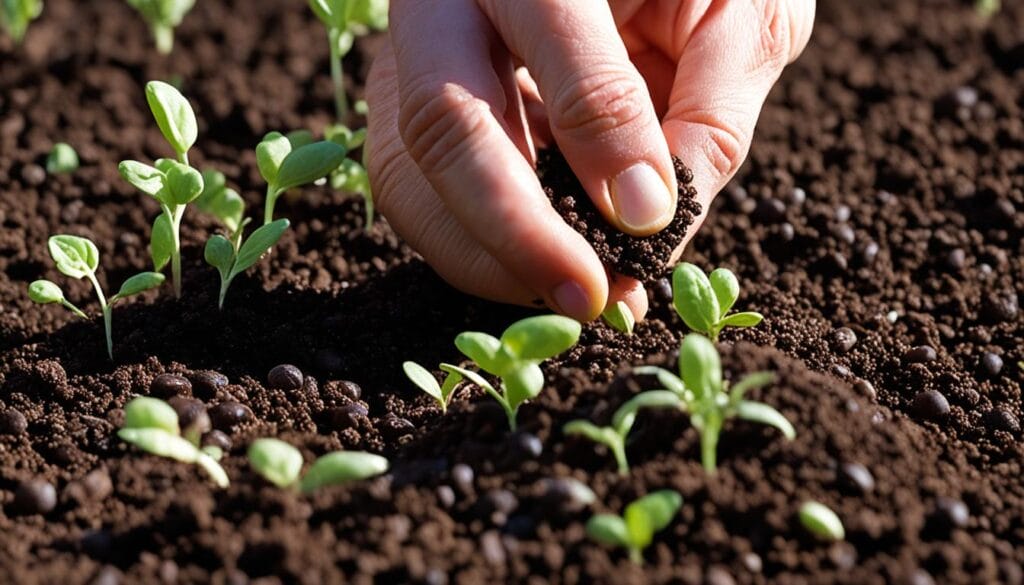
Table: Recommended Seeds for Direct Germination
| Plant | Type | Adaptability |
|---|---|---|
| Tomatoes | Vegetable | High |
| Zinnias | Flower | Moderate |
| Carrots | Root Vegetable | High |
| Lettuce | Leafy Green | High |
By selecting the right seeds and ensuring their adaptability to direct soil germination, you’re setting the foundation for a thriving garden. The next section will guide you through the process of sowing these seeds directly into the soil.
Sowing Seeds Directly Into the Soil
Now that you understand the importance of direct soil germination and have prepared your soil, it’s time to sow your seeds directly into the ground. This method provides the seeds with the ideal environment for germination and growth, ensuring a successful gardening experience.
Ideal Sowing Depth and Spacing
When sowing seeds directly into the soil, it’s crucial to consider the ideal sowing depth and spacing for different types of seeds. While each seed has its own specific requirements, a general rule of thumb is to sow seeds at a depth of approximately two to three times their diameter. This allows for proper moisture absorption and root development.
The spacing between seeds is equally important to ensure adequate room for plants to grow and thrive. Refer to seed packets or online resources for specific recommendations on spacing, as it can vary depending on the type of plant and its growth habits.
Techniques for Successful Direct Sowing
Direct seeding can be done in various ways, depending on your preference and the type of seeds. Here are a few popular techniques for successful direct sowing:
- Traditional Rows: Create straight, evenly spaced rows in your garden bed using a garden hoe or rake. Sow seeds along the rows at the appropriate depth and spacing.
- Broadcasting: Suitable for smaller seeds, broadcasting involves scattering seeds over the soil surface and gently raking them in. This method allows for more natural, random growth patterns.
- Hills or Mounds: This technique is often used for larger seeds or plants that require more space. Create small hills or mounds of soil and sow several seeds on each mound.
Remember to gently cover the seeds with soil after sowing and lightly water them. Avoid over-compacting the soil, as this can hinder germination and root development.
Direct sowing seeds into the soil offers numerous benefits, including enhanced root development and reduced transplant shock. It also allows plants to establish a strong connection with the surrounding soil and environment, resulting in healthier and more resilient growth.
By following these tips and techniques, you’ll be well-equipped to sow your seeds directly into the soil and set your garden up for success.
Proper Watering Techniques
Proper watering is a critical aspect of successful direct soil germination. In order to ensure the healthy growth of your plants, it’s important to understand the importance of watering techniques. By providing the right amount of water at the right time, you can create an optimal environment for your seeds to thrive.
Overwatering and underwatering can have detrimental effects on your plants’ health. Let’s explore some key points to keep in mind when watering your direct germination garden:
- Timing: Watering in the early morning or late evening is ideal for direct soil germination. This allows the soil to absorb the water before the sun’s heat evaporates it. Avoid watering during the hottest part of the day to prevent water loss.
- Water Quantity: It’s important to strike a balance when it comes to the amount of water you provide. Too much water can lead to stagnant soil, which can suffocate the roots and promote the growth of harmful fungi and bacteria. On the other hand, insufficient water can cause dehydration and stunt the growth of your plants.
- Soil Moisture: Check the moisture level of the soil before watering. Stick your finger about an inch into the soil, and if it feels dry, it’s time to water. However, if the soil feels moist, it’s best to wait before watering again to prevent over-saturation.
Proper watering is the key to a healthy direct germination garden.
Remember, direct soil germination relies on the natural moisture in the soil to kickstart the seeds’ growth. By watering properly, you create the optimal conditions for the seeds to sprout and thrive.
Be mindful of the specific needs of different plants and adjust your watering schedule accordingly. Some plants may require more water, while others may tolerate drier conditions. Regularly monitoring your garden’s moisture levels will help you maintain the right balance.
Managing Watering Challenges
Providing Adequate Sunlight
Sunlight plays a vital role in the growth and development of plants. When it comes to direct soil germination, providing adequate sunlight is crucial for ensuring healthy and robust plant growth.
Direct seeding techniques, such as sowing seeds directly into the soil, offer numerous benefits for gardening enthusiasts. By bypassing the use of seed trays or pots, direct germination allows seeds to establish their root systems directly in the ground, leading to stronger and more resilient plants.
The benefits of direct germination are further enhanced when accompanied by proper sun exposure. Sunlight is essential for photosynthesis, the process where plants convert light energy into chemical energy to fuel their growth. By positioning your plants in areas with optimal sun exposure, you enhance their access to the sunlight they require to flourish.
When planning your garden, it’s crucial to identify the best areas for sun exposure. Observe the patterns of sunlight in your garden throughout the day to determine which areas receive the most light. Ideally, you want to choose locations that receive at least six hours of direct sunlight daily, as most plants require this minimum threshold to thrive.
Once you’ve identified the areas with adequate sunlight, strategically position your plants to optimize their exposure. Remember that the angle and intensity of sunlight can vary throughout the year, so it’s essential to monitor and adjust the positioning of your plants as needed.
By providing your plants with the right amount of sunlight, you give them the energy they need to grow, flower, and produce an abundant harvest. Additionally, proper sun exposure can contribute to disease prevention and overall plant vigor.
Remember to regularly check on your plants throughout the day, ensuring they receive an appropriate balance of sunlight and shade. With proper sun exposure, your direct soil germination efforts will yield remarkable results.
Direct Germination Tips for Maximizing Sunlight:
- Observe and identify areas with optimal sun exposure in your garden
- Position your plants strategically to make the most of the available sunlight
- Monitor and adjust the positioning of your plants as the angle and intensity of sunlight change throughout the year
- Regularly check on your plants to ensure they receive the right balance of sunlight and shade
By following these tips, you can provide the adequate sunlight your plants need for successful direct soil germination.
Managing Weeds and Pests
Weeds and pests can pose significant challenges to the success of direct soil germination. In this section, we will explore effective strategies for managing and preventing these issues, ensuring that your garden thrives. By incorporating organic methods such as proper mulching and companion planting, as well as utilizing natural pest repellents, you can overcome these obstacles and enjoy the benefits of direct germination.
Proper Mulching
One of the most effective ways to suppress weeds and conserve moisture in the soil is through proper mulching. Mulch acts as a protective layer, preventing weed growth by blocking sunlight and hindering their access to essential nutrients. Additionally, mulching helps retain moisture, reducing the need for frequent watering.
When selecting mulch materials, choose organic options such as straw, wood chips, or bark. These materials not only enrich the soil as they break down but also provide a natural barrier against pests. Apply a layer of mulch around your plants, ensuring it is at least two to three inches thick, to create an effective weed and pest deterrent.
Companion Planting
Companion planting involves strategically grouping plants that benefit each other, either by repelling pests or enhancing growth. By harnessing the power of companion planting, you can create a natural defense system against common garden pests.
For example, planting marigolds alongside your vegetables can help deter pests such as aphids and nematodes. The strong scent of marigolds acts as a natural repellent, protecting your plants from potential damage. Similarly, planting aromatic herbs like basil, mint, or rosemary can help repel insects while adding flavor to your culinary endeavors.
Natural Pest Repellents
In addition to mulching and companion planting, there are various natural pest repellents that you can utilize to protect your garden during direct soil germination. These repellents are not only effective but also environmentally friendly, ensuring the health of your garden ecosystem.
One popular option is neem oil, which is derived from the neem tree and acts as a natural insecticide. Dilute neem oil with water according to the manufacturer’s instructions and spray it on your plants to deter pests. Additionally, homemade insecticidal soap, made by combining mild liquid soap with water, can also be effective in controlling pests without harming your plants or the environment.
Safeguarding your garden against weeds and pests is vital for ensuring a successful direct soil germination process. By implementing these organic methods, you can create a thriving garden environment that promotes healthy plant growth and maximizes the benefits of direct germination.
| Pest | Prevention | Treatment |
|---|---|---|
| Aphids | Attract natural predators like ladybugs and lacewings. | Apply insecticidal soap or neem oil. |
| Slugs and Snails | Use copper barriers or beer traps. | Handpick and dispose of them. |
| Caterpillars | Plant dill or parsley to attract caterpillar-hunting wasps. | Remove caterpillars by hand or use natural pesticide. |
Nutrient Enrichment for Healthy Growth
Proper nutrient enrichment is essential for promoting healthy growth in plants that undergo soil-based germination using the direct germination method. By providing the right balance of essential nutrients, you can ensure that your plants have the necessary resources to thrive and produce bountiful harvests. In this section, we will explore various methods for enriching the soil and creating a nutrient-rich environment for your plants.
Composting: A Natural Nutrient Source
Composting is an excellent way to provide organic matter and essential nutrients to your soil. It involves the decomposition of organic waste, such as kitchen scraps, yard trimmings, and leaves, into nutrient-rich compost. By adding compost to your garden beds or containers, you can improve soil structure, enhance moisture retention, and provide a steady release of nutrients over time. Consider starting a compost pile or using commercially available compost to enrich your soil.
The Power of Organic Fertilizers
Organic fertilizers are another effective method for nutrient enrichment in soil-based germination. These fertilizers derive from natural sources, such as animal manure, composted plant materials, and bone meal. They provide a wide range of essential nutrients that plants need for growth and development. When choosing organic fertilizers, look for options that are specifically formulated for the types of plants you are growing and follow the recommended application rates.
The Importance of Soil Testing
Soil testing is a crucial step in understanding the nutrient composition of your soil and identifying any deficiencies or imbalances. By conducting regular soil tests, you can make informed decisions about the types and quantities of fertilizers to apply. It allows you to tailor your nutrient enrichment efforts to meet the specific needs of your plants. Consider sending soil samples to a reputable laboratory or using DIY soil test kits for quick and convenient results.
Creating a Nutrient Enrichment Schedule
To ensure consistent nutrient availability throughout the growing season, it is essential to follow a nutrient enrichment schedule. This involves providing supplemental nutrients at specific intervals based on the plant’s growth stages and nutritional requirements. Refer to plant-specific guidelines or consult with local horticultural experts to determine the optimal timing and dosage of fertilizers for your plants.
Incorporating these methods for nutrient enrichment into your garden maintenance routine will contribute to the overall success of your soil-based germination and direct germination techniques. The next section will address common issues that may arise during the direct soil germination process and provide troubleshooting tips to overcome them.
Troubleshooting Common Issues
Even with careful planning and following the direct seeding technique, challenges may arise during the direct soil germination process. Understanding and addressing common issues is essential to ensure the success of your garden. In this section, we will explore several common problems that gardeners may encounter and provide valuable troubleshooting tips to help you overcome them.
1. Slow Germination
Slow germination can be frustrating, but it is a common issue that gardeners may face. The key to resolving this problem is understanding the factors that may affect the germination process. These factors can include temperature, moisture levels, and the viability of the seeds. Here are some tips to help you speed up the germination process:
- Ensure that the soil temperature is within the optimal range for the specific plant species
- Provide consistent moisture by watering the soil regularly, but avoid overwatering, as it can lead to rotting
- Check the seed viability by conducting a simple germination test before sowing
- Consider using seed starting mixtures or pre-soaking seeds to enhance germination
2. Diseases and Pests
Diseases and pests can pose significant challenges to the germination and growth of your plants. Identifying the specific disease or pest is crucial for effective management. Here are some steps you can take to prevent and address these issues:
- Maintain good garden hygiene by removing any dead plant material or weeds that may harbor diseases or pests
- Practice crop rotation to prevent the build-up of disease-causing pathogens in the soil
- Consider using natural pest control methods, such as introducing beneficial insects or applying organic pest repellents
3. Nutrient Deficiencies
Nutrient deficiencies can impair the growth and development of your plants. It is essential to identify the specific nutrient deficiencies and take appropriate measures to address them. Here are some tips to help you resolve nutrient deficiencies:
- Perform a soil test to determine the nutrient levels and identify any deficiencies
- Amend the soil with organic fertilizers or compost to replenish the lacking nutrients
- Consider using foliar sprays or nutrient-rich compost teas to provide an immediate nutrient boost to the plants
Remember, direct germination in soil offers several benefits, including natural root development and reduced transplant shock. By troubleshooting common issues, you can ensure the success of your garden and reap the benefits of direct germination.
| Common Issues | Troubleshooting Tips |
|---|---|
| Slow Germination | Ensure optimal soil temperature and moisture levels, test seed viability, and consider using seed starting mixtures or pre-soaking seeds. |
| Diseases and Pests | Maintain good garden hygiene, practice crop rotation, and use natural pest control methods. |
| Nutrient Deficiencies | Perform a soil test, amend the soil with organic fertilizers or compost, and use foliar sprays or nutrient-rich compost teas. |
Harvesting and Maintaining the Garden
Successful direct soil germination leads to bountiful harvests. Once your plants have grown strong and healthy, it’s time to reap the rewards of your hard work. In this section, we will guide you through the process of harvesting and maintaining your garden to ensure continued success.
Harvesting Techniques
Knowing when and how to harvest your crops is essential to maximize their flavor and nutritional value. Here are some general guidelines for common garden vegetables:
- Leafy greens: Harvest the outer leaves as needed, allowing the plant to continue producing.
- Root vegetables: Gently loosen the soil around the base of the plant and pull the root out.
- Fruit-bearing plants: Harvest fruits when they are fully ripe, using sharp pruners or shears to avoid damaging the plant.
Maintaining Garden Health
To ensure the long-term success of your garden, it’s important to maintain its health and vitality. Here are some key tasks to keep your garden thriving:
- Crop rotation: Rotate your plants each year to prevent the buildup of pests and diseases in the soil.
- Weed control: Regularly remove weeds to reduce competition for nutrients and water.
- Soil enrichment: Test the nutrient levels of your soil and amend as needed with organic fertilizers or compost.
- Pest management: Monitor your plants for pests and employ natural pest control methods such as companion planting and insect-repelling herbs.
By implementing these practices, you can maintain a productive and thriving garden year after year.
| Garden Maintenance Checklist |
|---|
| 1. Crop rotation |
| 2. Weed control |
| 3. Soil enrichment |
| 4. Pest management |
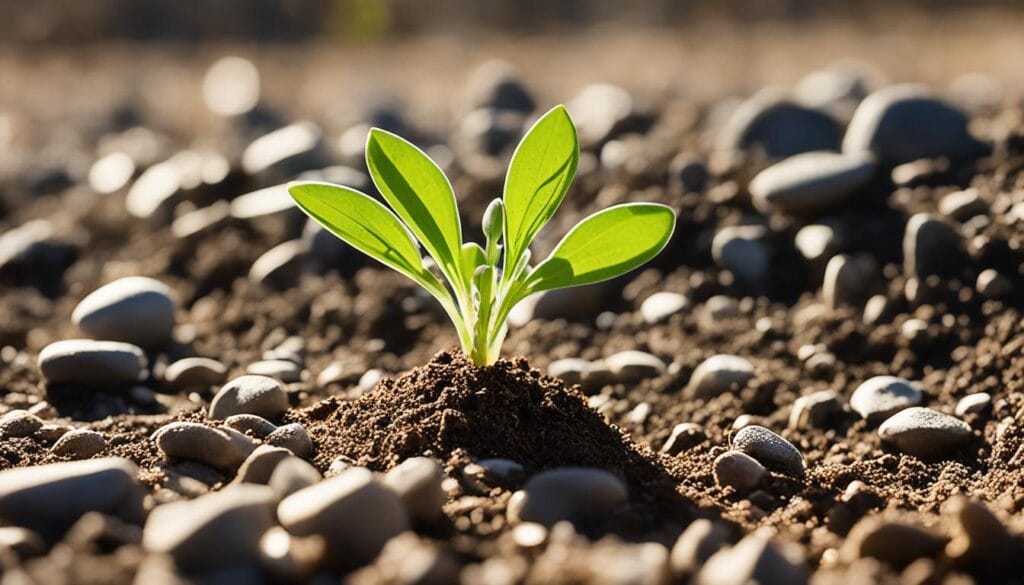
“A garden requires patient labor and attention. Plants do not grow merely to satisfy ambitions or to fulfill good intentions. They thrive because someone expended effort on them.” – Liberty Hyde Bailey
Maintaining a garden may require labor and attention, but the rewards are well worth it. With proper care and maintenance, your garden will continue to flourish, providing you with fresh, nutritious produce and a sense of fulfillment.
Conclusion
To achieve successful gardening, direct soil germination is a technique that cannot be overlooked. Throughout this article, we have explored the benefits and intricacies of this method, providing readers with valuable tips and techniques.
By opting for direct soil germination, gardeners can create an optimal environment for their seeds to thrive. It allows for natural growth and development, resulting in healthier and more robust plants.
Remember to prepare the soil properly, select the right seeds, and sow them directly into the soil. Adequate watering, sunlight exposure, and managing weeds and pests are also crucial for success. Additionally, enriching the soil with nutrients and addressing common issues will further ensure a productive garden.
To delve deeper into direct soil germination and access additional resources and information, visit SeedsHereNow.com. Start implementing these techniques today and enjoy the fruitful results of your gardening endeavors.
Now that you understand the direct soil germination method, get your garden started by shopping the collection of regular, feminized, and autoflower cannabis seeds at Seeds Here Now.
FAQ
What is direct soil germination?
What are the benefits of direct soil germination?
How does direct soil germination differ from other methods?
What is the process of direct soil germination?
How do I prepare the soil for direct germination?
How do I select the right seeds for direct germination?
What are the ideal sowing depths and spacing for direct soil germination?
How should I water the seeds during direct germination?
Why is providing adequate sunlight important for direct soil germination?
How do I manage weeds and pests during direct soil germination?
How can I enrich the soil with nutrients for healthy growth?
What are some common issues that may arise during direct soil germination?
How do I harvest and maintain the garden after direct soil germination?
Back

